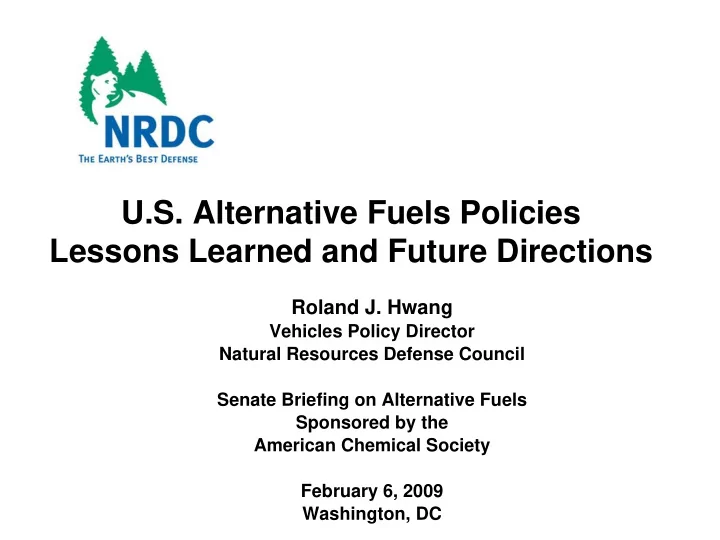

U.S. Alternative Fuels Policies Lessons Learned and Future Directions Roland J. Hwang Vehicles Policy Director Natural Resources Defense Council Senate Briefing on Alternative Fuels Sponsored by the American Chemical Society February 6, 2009 Washington, DC
Policy Crossroads for Fuels • Can we develop an effective, durable policy framework to ensure the transportation fuel supply system can effect a smooth, orderly transition from conventional oil to alternative fuels that will allow the US to meet its energy security and climate change goals? Slide 2
Overall Summary of US Alternative Fuel Policy Experience… • The bad news is that… Alternative Fuel Consumption, 2006 (Source: EIA) million gasoline- – 20 years of US Fuel Type percentage equivalent gallons alternative fuel policy, Gasoline + Diesel 184,393 Ethanol in gasoline 3,729 2.0% have resulted in less Biodiesel 261 0.1% than 3% displacement of Compressed Natural Gas 172 0.1% Liquefied Natural Gas 173 0.1% oil used in the motor Other 503 0.3% vehicle sector. Total Alternative Fuels 4,837 2.6% Slide 3
Overall Summary of US Alternative Fuel Policy Experience… • The good news is that… – Policies have pushed the oil and auto industries to make cleaner gasoline and diesel fuels, and cleaner cars and trucks. – Stimulated investments and innovation in clean fuel technologies . • Is this time around different? Key factors that contributed to past “failures” are changing: – Record high fuel prices – Peaking of “conventional” oil especially in non-OPEC countries – Growing likelihood of mandatory controls on emissions contributing to global warming Slide 4
Key Alternative Fuel Policies • Alternative Motor Fuels Act of 1988 (AMFA) – CAFE credits for manufacturing AFVs (fuel flexible vehicles) • Clean Air Act of 1990 (CAA) – Mandated oxygenate usage in gasoline (MTBE, ethanol) • Energy Policy Act of 1992 (EPAct) – Alternative fuel-capable vehicle purchase requirements for fleets • California Zero-Emission Vehicle Mandate (1990) – Production mandate for super clean vehicles • Renewable Fuel Standard (EPAct 2005 and EISA of 2007) – Replaced oxygenate mandate with ethanol volumetric requirement Slide 5
Flex Fuel Vehicle Credits (AMFA) • AMFA FFV credits help increase the number of alternative fuel vehicles on the road, but failed to ensure they run on E85. (RFS may help remedy) Of over 6 million FFVs on road, only roughly 300K (5%) actually use ethanol in the form of E85 (85% ethanol, 15% gasoline) Slide 6
Low Blend Strategy (Ethanol) • CAA oxygenate blending 4,000 requirement (and later the 3,500 RFS) has been the most 3,000 million gasoline-eq gallons “successful” (in terms of oil 2,500 displacement) strategy. 2,000 • While ethanol currently 1,500 accounts for about 75% of 1,000 500 alternative fuel use, it is still 0 less than 3% of total motor Ethanol in Biodiesel Compressed Liquefied Other gasoline Natural Gas Natural Gas vehicle fuel supply. Slide 7
Fleet Purchase (EPAct 1992) McNutt and Rodgers, “Lessons Learned from 15 Years of Alternative Fuel Experience, 1998-2003”, US DOE, 2003. Slide 8
Existing Fuels Got Much Better • Gasoline and diesel were able to compete far better than anticipated on reducing criteria air pollutants – California’s efforts to transition to methanol (M85) in late 80’s resulted in ARCO’s developing reformulated gasoline – California’s ZEV program resulted in super clean gasoline cars (PZEVs and conventional hybrids) – Fleet mandates for CNG buses and trucks have been slowed by “clean diesel” trucks and hybrid buses Slide 9
Climate Policy can do Double Duty • But promoting domestic petroleum and high carbon fuels will make meeting climate objections much harder. Slide 10
Key Existing Policies • Federal Renewable Fuel Standard (“RFS 2” of EISA07) – Mandates 36 billion gallons of renewable fuels by 2022 – However, greenhouse gas benefits are modest due to grandfathering and does not promote other low carbon fuels, like electricty for plug- in hybrids • California Low Carbon Fuel Standard – Performance-based, fuel neutral GHG standards on gasoline and diesel fuels. Will be adopted by CARB in April 2009. • California Zero Emission Vehicle Program – Requires about 58,000 Plug in Vehicles in the 2012-14 timeframe in CA, 3 times since 13 other states currently have California’s program Slide 11
Key Design Elements, Transportation Climate Architecture Transportation Fuels Included in the Cap Fuel provider required to submit allowances for fossil-fuel end use Direct Measures & Standards Performance-based Vehicle emission and/or . . Incentives efficiency standards Retooling funds for auto Low-Carbon Fuel Standard factories, cellulosic ethanol, Smart Growth policies smart growth projects Slide 12
Emerging Consensus for Fuels Policy Framework? USCAP Blueprint • Inclusion of fossil-based transportation fuels in an economy-wide cap-and-trade system in combination with environmentally effective and cost- effective complementary measures for all of the major components of the transportation system. • EPA development of a GHG Performance Standard for Transportation Fuels to replace RFS • Federal support for pre-commercial, early commercial and higher-risk phases of technology research and development for technologies that represent “breakthrough innovations” including 3 Auto: GM, Ford, Chrysler advanced low-carbon fuels and the 3 Oil: BP, ConocoPhillips, Shell vehicle 5 NGOs: NRDC, EDF, Pew, TNC, WRI 2 Chemical Companies: DuPont and Dow 18 0ther members http://www.us-cap.org/ Slide 13
Recommendations • Need comprehensive approach combining binding targets, standards on vehicles and fuels, and incentives. • Standards should, to the greatest extent possible, be fuel- neutral, performance-based (i.e., Low Carbon Fuel Standard) • Incentives should be provided in a performance-based manner to a portfolio of the most promising fuels and technologies. • Targeted policies (such as production mandates), for truly advanced, ultra clean technologies, may be necessary in order to ensure certainty for investors in risky, but extremely promising technologies. Slide 14
Recommend
More recommend